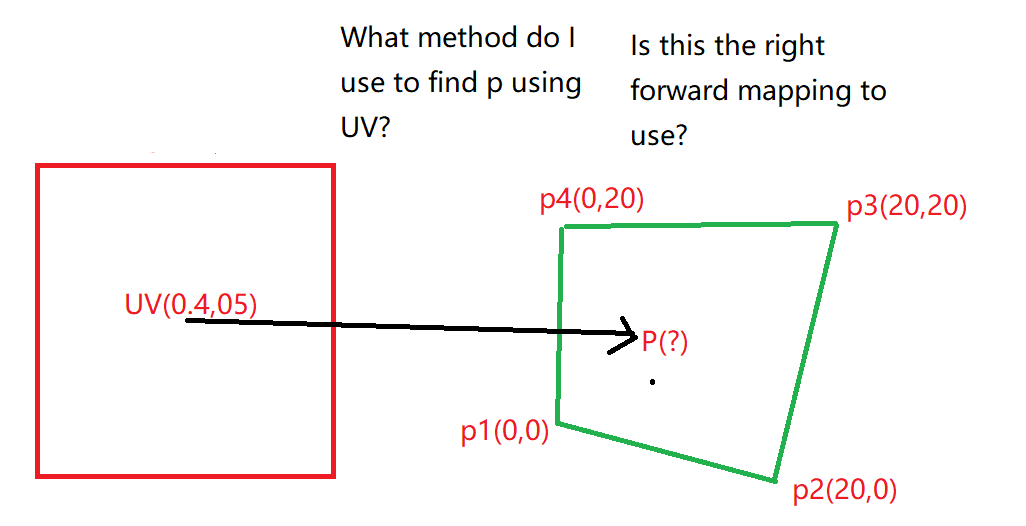env win10>x3050ti&opengl4.0
With the information you’ve provided all I can say is:
- presumable you somehow map the quadrilateral on the right to an area of your screen (or is it a texture?) on the left
- the inverse of that mapping is what you are looking for
Taking a wild guess you may be looking for the functionality of glm::unproject or gluUnProject?
The forward mapping is straightforward:
p = mix(mix(p1,p2,u),mix(p4,p3,u),v);
Where mix(a,b,t) = (1-t)a+tb = a+t(b-a) and u,v are in [0,1] (so u=x/width, v=y/height).
For the inverse mapping, if you expand out the forward mapping you get a pair of bilinear equations. Solve one for u, substitute into the second to get a quadratic in v, solve using the quadratic formula, substitute back into the first to get u (or repeat the process, solving the first for v then the second for u). You’ll want to use a computer algebra system (Mathematica, Wolfram Alpha, etc); it’s too messy to solve by hand. Or search for “inverse bilinear mapping”.
Is the following url a forward mapping?
Is the following url a inverse mapping?
God, I only know how to do math. Can you confirm that for me or Are there any open source libraries available?
Both of those start with the forward mapping and demonstrate how to invert it.
Do I mapping from pixel coordinate to geometric coordinate using a forward method?If I use the inverse mapping,Is the following call correct?
vec2 geoPos = invBilinear(p(800,410), in vec2(0,0), vec2(10,0), vec2(20,20), vec2(0,20))
float cross( in vec2 a, in vec2 b ) { return a.x*b.y - a.y*b.x; }
vec2 invBilinear( in vec2 p, in vec2 a, in vec2 b, in vec2 c, in vec2 d )
{
vec2 res = vec2(-1.0);
vec2 e = b-a;
vec2 f = d-a;
vec2 g = a-b+c-d;
vec2 h = p-a;
float k2 = cross2d( g, f );
float k1 = cross2d( e, f ) + cross2d( h, g );
float k0 = cross2d( h, e );
// if edges are parallel, this is a linear equation
if( abs(k2)<0.001 )
{
res = vec2( (h.x*k1+f.x*k0)/(e.x*k1-g.x*k0), -k0/k1 );
}
// otherwise, it's a quadratic
else
{
float w = k1*k1 - 4.0*k0*k2;
if( w<0.0 ) return vec2(-1.0);
w = sqrt( w );
float ik2 = 0.5/k2;
float v = (-k1 - w)*ik2;
float u = (h.x - f.x*v)/(e.x + g.x*v);
if( u<0.0 || u>1.0 || v<0.0 || v>1.0 )
{
v = (-k1 + w)*ik2;
u = (h.x - f.x*v)/(e.x + g.x*v);
}
res = vec2( u, v );
}
return res;
}
What exactly are you trying to do? If you’re implementing bilinear texture mapping, you’d normally use an inverse mapping using the positional coordinates followed by a forward mapping using the texture coordinates. If the texture coordinates are the unit square, you can omit the forward mapping.
This topic was automatically closed 183 days after the last reply. New replies are no longer allowed.


